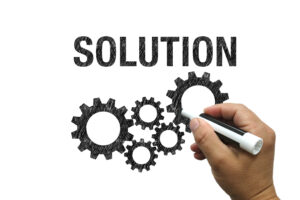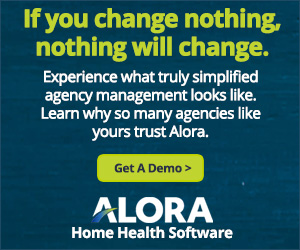
08 Jul Eight steps to Improve Your Home Health Agency Processes & Workflows
What are the keys to continuous homecare process improvement?
Putting your home health care agency’s success at the forefront requires a good deal of discipline, planning, and an earnest and thorough assessment of the operational processes currently in place. In short, growth and success hinge largely on leadership’s ability to evaluate workflows and standardize operations, keying in on areas to improve, and then acting. In this blog, we will cover eight crucial steps to get you going.
Defining and analyzing your processes, and workflows?
To kick things off, let’s first define ‘process’ and ‘workflow’. The terms are often used interchangeably but are different in their definitions and in how to evaluate each one.
- A process is a series of steps or actions that accomplish a specific purpose.
- Workflow is a sequence of processes through which work moves from start to finish – or initiation to completion.
One analogy to explain process improvement initiatives is the idea that process evaluation can seem a little like opening Pandora’s Box – you just don’t know what you will find or how many processes will need to be evaluated and/or updated. This rings true particularly since processes within an agency can and will impact multiple departments and workflows in operations.
What does it mean to open Pandora’s Box? Multiple processes are included to complete a workflow during daily agency operations. If one process is changed, then it is possible to break the entire workflow. The result is each process will need to be evaluated and the workflow adjusted as needed to continue to operate efficiently. Therefore, Pandora’s Box can create a perceived chaos that needs to be tamed and realigned with the agency’s strategic goals and objectives.
So what exactly does one do when Pandora’s box is open and it becomes overwhelming to decide where to begin? Let’s dive into eight steps for an agency to rule the chaos borne out of Pandora’s box and realign processes and workflows with your agency’s strategic goals and objectives.
Step one: Define the purpose and scope of the evaluation. Answer and document the following questions:
-
- What specifically are you trying to accomplish?
- What are the boundaries of the evaluation? (should there be any exclusions?)
- Who are the stakeholders and users that will be impacted by the results?
Step two: Gather feedback from your team. Interview members of the team involved in the process. Conduct the interviews individually not collectively to be able to evaluate for inconsistencies or redundancies in the next steps. Use a method you are most comfortable with to gather the information that will help you evaluate consistency, redundancy, and efficacy.
-
- Conduct face-to-face interviews
- Create a brief anonymous survey to increase the chance of honest and unbiased answers.
Step three: Map the process as it is. Take the feedback in step 2 and use a flowchart, diagram, outline, matrix, or other tool of your preference and map the process as defined by your team. Map it as it currently is – not how you want it to function. Give a visual representation of what your team is doing. A picture is worth a thousand words.
-
- Define inputs and outputs.
- Define roles and responsibilities.
- Identify dependencies across other processes or workflows.
Step four: Analyze the data collected on the performance of the process. You can use quantitative or qualitative data in the analysis or a combination of both to measure performance and outcomes.
-
- Define your data collection methods.
- Define the indicators for success or failure.
- Determine if the process is meeting the goals and objectives.
- Identify where processes may be redundant.
Step five: Take a systemic approach to process and workflow analysis. Do not focus on isolating each process individually but evaluate how multiple processes impact each other; thereby impacting workflow. Improving one process may (and probably will) impact other processes in the workflow, either positively or negatively. One process may reduce costs, but it could increase the complexity of another process.
-
- Avoid unintended consequences or tradeoffs for performance.
- Do not compromise the overall performance of the agency.
Step six: Identify the strengths and weaknesses of the processes. A SWOT (strengths, weaknesses, opportunities, and threats) analysis is a great tool to identify areas of improvement and threats that will hinder progress.
-
- What factors will hinder improvement initiatives?
- What opportunities exist to improve?
Step seven: Prioritize processes and workflows for improvement. Consider the entire workflow. If process numbers one and two out of five in the workflow are broken and need to be updated, then the entire workflow must be evaluated objectively. Each process must be evaluated for impact so the entire workflow will flow efficiently.
-
- Determine what process will bring the best results.
- Determine the benefits and risks of altering the process.
- Determine the amount of resources available, including personnel, time, and financial resources.
Step eight: Monitor the improvements. The tools you use to monitor the effectiveness of process improvements are up to you if you are consistent with the tools you use such as feedback loops, Gantt charts, or software applications.
Make it happen – The Takeaways
 In conclusion, undertaking actions to improve an agency’s workflow and processes can be overwhelming, especially if process improvement initiatives are not managed effectively. When performing a process and workflow evaluation with processes that impact each other, do not focus on a single process at a time. When analyzing the process as mapped, determine where the processes intersect, overlap, or become redundant. Determine the impact, whether positive or negative, on the overall performance of the workflow within the agency.
In conclusion, undertaking actions to improve an agency’s workflow and processes can be overwhelming, especially if process improvement initiatives are not managed effectively. When performing a process and workflow evaluation with processes that impact each other, do not focus on a single process at a time. When analyzing the process as mapped, determine where the processes intersect, overlap, or become redundant. Determine the impact, whether positive or negative, on the overall performance of the workflow within the agency.
Perform a SWOT analysis for strengths and weaknesses of the process and look for opportunities to improve. Utilize other technology and organizational tools such as home health software that can standardize reports and streamline dashboards and charts that track and display organizational health metrics and workflows. As you move forward, monitor process improvement initiatives for results and make additional changes as indicated, putting your agency on the path to greater overall operational health and success.
Author’s Note: Views, information, and guidance in this resource are intended for information only. We are not rendering legal, financial, accounting, medical, or other professional advice. Alora disclaims any liability to any third party and cannot make any guarantee related to the content.
Additional related blogs:

Alora’s home health software solution is ideal for agencies operating in both skilled and non-skilled care. Managing workflow for administrative and caregiving staff becomes easier with the right technology tools. Alora has been engineered with the goal of simplification of day-to-day tasks in the office and in the field, allowing agencies to focus on patient care, workflow efficiency, and growth.




No Comments